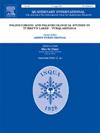Reconstruction of landscape change of Shyok valley, Ladakh during Late Quaternary using OSL technique
IF 1.9
3区 地球科学
Q3 GEOGRAPHY, PHYSICAL
引用次数: 0
Abstract
The Shyok Valley, within the Upper Indus Basin in Trans-Himalayas, lies in the cold and arid region. It is fed by the Siachen glacier; the largest glacier in the third pole. The fluctuations in this glacier are attributed to varying intensities of the two weather regimes namely mid-latitude westerlies and Southwest Monsoon. The reconstruction of the magnitude, timing, and landscape impact of glaciers in Nubra-Shyok valley have been explored in past decade yet they are contentious and uncertain. Therefore, the present study investigates the sediments from the key sites (Agham, Khardung, Changmar, Chalunka) in the Shyok valley using Optically Stimulated Luminescence (OSL) dating technique. The diverse geomorphology, including moraines, sand dunes, mass movement zone, alluvial fans are mapped to represent the geomorphic setting of the region. The chronological ages from the lower Shyok Valley (Agham section: 18.4 ± 2.2 ka) suggest extensive glacier expansion beyond the present terminus of the Siachen Glacier during the Marine Isotopic Stage (MIS)-2. The Khardung section has glaciofluvial deposits: 24.0 ± 2.4 ka (KHG-1), younger moraine: 8.2 ± 1.0 ka (KHG-9) and lacustrine deposits (KHGL-5, KHGL-6, KHGL-7): 14.1 ± 2.0 ka, 12.1 ± 1.1 ka, 10.7 ± 1.3 ka. The glacial events that occurred around 8.2 ka and 12.0 ka suggest glacial advancement which are likely due to a period of lower temperature. The Changmar section displays lacustrine deposits and debris flow events dated to the late glacial (14.5 ± 1.7 ka, CHG-1; 13.2 ± 1.6 ka, CHG-2) and deglaciation period (6.5 ± 1.2 ka, CHG-3; 5.5 ± 1.0 ka, CHG-4). The presence of the Holocene-aged lateral moraines (20 km away from Chalunka village: 14.3 ± 1.3 ka, CLM-2; 5.7 ± 0.9 ka, CLM-3; 0.4 ± 0.04 ka, CLM-4) and CHG-8: 2.1 ± 0.3 ka; outwash plain deposits: COP-7: 2.4 ± 0.4 ka aligns with the previous findings in the Nubra Valley, suggesting glacial advance in Little Ice Age in the whole valley. The glacial event occurring between 2.4 and 2.1 ka corresponds to the Neoglacial epoch, characterized by a glacial advance likely caused by a decrease in temperature during the late Holocene period. The intensified mid-latitude westerlies during MIS-2 are inferred to be the key factor in increased moisture to the Shyok Valley which led to the glacier expansion. These findings enhance our understanding of past climate changes in this high-altitude region and serve as a valuable baseline for future studies on glacial response to climate variations.
利用 OSL 技术重建第四纪晚期拉达克希约克山谷的地貌变化
西约克山谷位于外喜马拉雅山脉的上印度河盆地,地处寒冷干旱地区。它的水源来自第三极最大的冰川--锡亚琴冰川。该冰川的波动可归因于两种天气状况(即中纬度西风和西南季风)的不同强度。在过去的十年中,人们对努布拉-肖克河谷冰川的规模、时间和景观影响的重建进行了探索,但仍存在争议和不确定性。因此,本研究采用光学激发荧光(OSL)测年技术,对斯约克河谷主要地点(阿甘、哈当、昌玛、恰伦卡)的沉积物进行了调查。绘制了包括冰碛、沙丘、大规模运动区和冲积扇在内的各种地貌图,以代表该地区的地貌环境。下斯约克河谷(阿甘段:18.4 ± 2.2 ka)的年代学年龄表明,在海洋同位素阶段(MIS)-2 期间,冰川大面积扩张,超过了现在的锡亚琴冰川终点。哈东(Khardung)断面的冰川流积物:24.0 ± 2.4 ka (KHG-1),年轻冰碛:8.2 ± 1.0 ka (KHG-9),以及湖积物(KHGL-5, KHGL-6, KHGL-7):14.1 ± 2.0 ka, 12.1 ± 1.1 ka, 10.7 ± 1.3 ka。在 8.2 ka 和 12.0 ka 前后发生的冰川事件表明,冰川期的提前很可能是由于温度较低所致。昌马剖面显示了冰川晚期(14.5 ± 1.7 ka,CHG-1;13.2 ± 1.6 ka,CHG-2)和冰川消融期(6.5 ± 1.2 ka,CHG-3;5.5 ± 1.0 ka,CHG-4)的湖泊沉积和泥石流事件。全新世时期的侧碛(距 Chalunka 村 20 公里,CHG-3,14.3 ± 1.3 ka;CHG-4,5.5 ± 1.0 ka;CHG-5,14.3 ± 1.3 ka):14.3±1.3ka,CLM-2;5.7±0.9ka,CLM-3;0.4±0.04ka,CLM-4)和 CHG-8:2.1±0.3ka;冲积平原沉积:COP-7:2.4 ± 0.4 ka 与之前在努布拉河谷的发现一致,表明整个河谷在小冰河时期出现了冰川作用。发生在 2.4 ka 到 2.1 ka 之间的冰川事件对应于新冰期,新冰期的特点是冰川前进,这可能是由于全新世晚期气温下降造成的。据推断,MIS-2 期间加强的中纬度西风是导致希约克河谷湿度增加的关键因素,而湿度增加又导致了冰川扩张。这些发现加深了我们对这一高海拔地区过去气候变化的了解,为今后研究冰川对气候变化的反应提供了宝贵的基准。
本文章由计算机程序翻译,如有差异,请以英文原文为准。
求助全文
约1分钟内获得全文
求助全文
来源期刊

Quaternary International
地学-地球科学综合
CiteScore
5.60
自引率
4.50%
发文量
336
审稿时长
3 months
期刊介绍:
Quaternary International is the official journal of the International Union for Quaternary Research. The objectives are to publish a high quality scientific journal under the auspices of the premier Quaternary association that reflects the interdisciplinary nature of INQUA and records recent advances in Quaternary science that appeal to a wide audience.
This series will encompass all the full spectrum of the physical and natural sciences that are commonly employed in solving Quaternary problems. The policy is to publish peer refereed collected research papers from symposia, workshops and meetings sponsored by INQUA. In addition, other organizations may request publication of their collected works pertaining to the Quaternary.
 求助内容:
求助内容: 应助结果提醒方式:
应助结果提醒方式:


